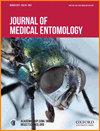Blinded by the light: does heat or light enhance wild mosquito (Diptera: Culicidae) attraction to CO2-baited traps in the Great Salt Lake area?
IF 2
3区 农林科学
Q1 ENTOMOLOGY
引用次数: 0
Abstract
The New Jersey Light Trap has been among the earliest trap models used for mosquito surveillance in the United States. This trap was modernized in the 1950s to the miniature CDC light trap, with the addition of CO2 following soon after. The incandescent light has the tendency to attract nontarget insects, as well as losing a substantial portion of their energy as heat. Few studies have delineated whether heat or light in isolation make a difference in field collections using the former traps within the United States. Our study focused on isolating heat and light variables by using incandescent bulbs, light emitting diode (LED) bulbs, and electric heating patches affixed to a base model CO2 trap as designed at the Salt Lake City Mosquito Abatement District. Sites were selected in the urban and suburban foothills and canyons of the Wasatch Mountain front, industrial areas near the Salt Lake City International Airport, and rural wetlands in the marshes outlying the Great Salt Lake. Five traps were replicated within each sector during the summer and fall summer seasons. Collections were composed of Aedes dorsalis (Meigen), Culex pipiens L., Culex tarsalis Coquillett, and Culiseta inornata (Williston). Composition changes were a result of seasonal, rather than spatial, shifts. The results showed that LED light traps depressed collections of key species. Otherwise, there were negligible differences in collections among incandescent, heat film, and base model traps. In the Intermountain West, the miniature CDC trap is reliable enough to make programmatic decisions even if light usage varies by district.被光亮迷惑:热量或光亮会增强大盐湖地区野生蚊子(双翅目:蚊科)对二氧化碳诱饵诱捕器的吸引力吗?
新泽西灯光诱捕器是美国最早用于蚊虫监测的诱捕器型号之一。20 世纪 50 年代,这种诱捕器更新为微型 CDC 灯光诱捕器,不久后又增加了二氧化碳诱捕器。白炽灯有吸引非目标昆虫的倾向,而且会以热量的形式损失很大一部分能量。在美国使用前一种诱捕器进行野外采集时,很少有研究明确说明单独使用热量或光照是否会产生不同效果。我们的研究重点是通过使用白炽灯泡、发光二极管(LED)灯泡以及盐湖城灭蚊区设计的基本型二氧化碳捕集器上的电热片来隔离热量和光照变量。地点选在瓦萨奇山前的城市和郊区山麓和峡谷、盐湖城国际机场附近的工业区以及大盐湖外围沼泽地的农村湿地。在夏季和秋季的夏季,每个区域都有五个重复的诱捕器。采集到的伊蚊包括伊蚊(Meigen)、库蚊(Culex pipiens L.)、跗线库蚊(Culex tarsalis Coquillett)和 Culiseta inornata (Williston)。组成变化是季节性而非空间性变化的结果。结果表明,LED 灯光诱捕器抑制了主要物种的采集。除此之外,白炽灯诱捕器、热膜诱捕器和基本型诱捕器的捕获量差异微乎其微。在山间西部,微型 CDC 捕集器足够可靠,即使光的使用因地区而异,也能做出计划决策。
本文章由计算机程序翻译,如有差异,请以英文原文为准。
求助全文
约1分钟内获得全文
求助全文
来源期刊
CiteScore
4.60
自引率
14.30%
发文量
207
审稿时长
3-8 weeks
期刊介绍:
Journal of Medical Entomology is published bimonthly in January, March, May, July, September, and November. The journal publishes reports on all phases of medical entomology and medical acarology, including the systematics and biology of insects, acarines, and other arthropods of public health and veterinary significance. In addition to full-length research articles, the journal publishes Reviews, interpretive articles in a Forum section, Short Communications, and Letters to the Editor.

 求助内容:
求助内容: 应助结果提醒方式:
应助结果提醒方式:


